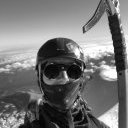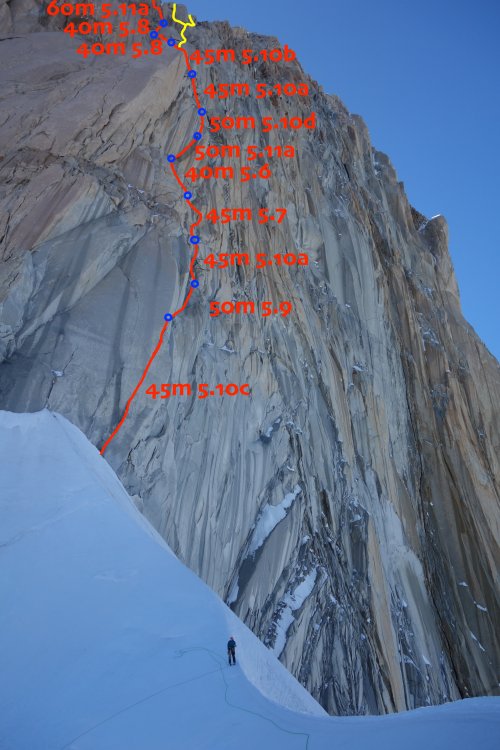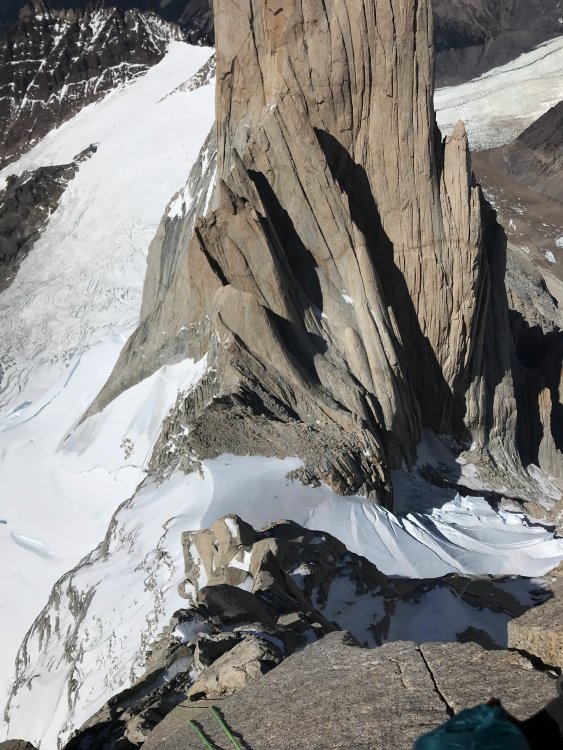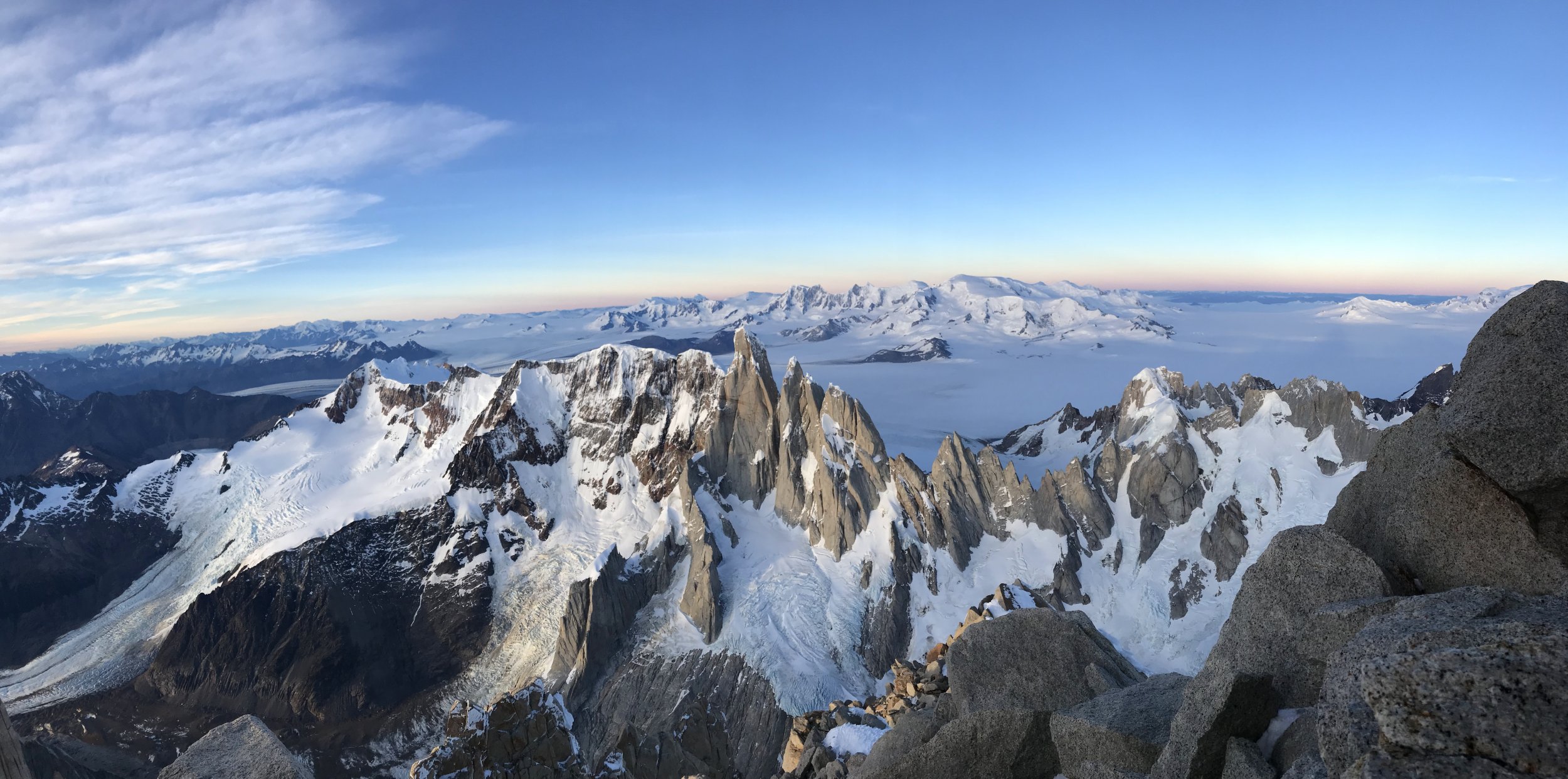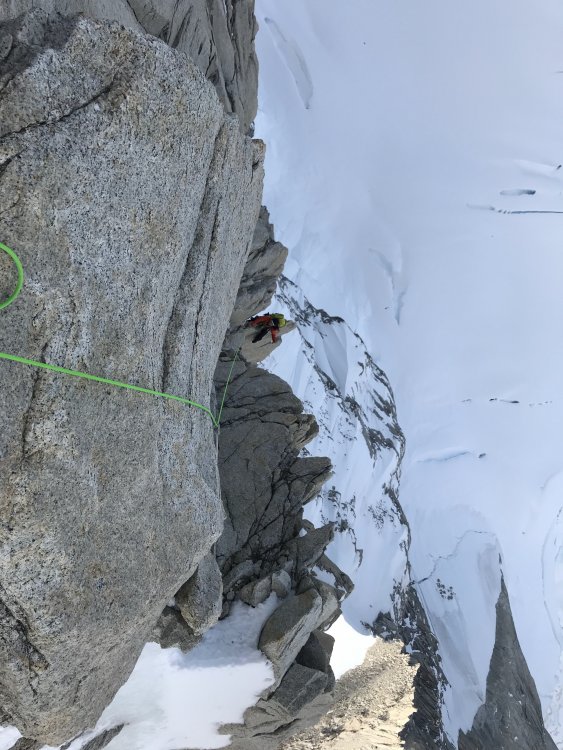Leaderboard
Popular Content
Showing content with the highest reputation on 03/05/19 in all areas
-
Trip: Patagonia - Fitz Roy Smash 'n' Grab 9 Days Seattle-to-Seattle Trip Date: 02/03/2019 Climbers: Jeff and Priti Wright Location: Patagonia - Chaltén Massif - El Chaltén, Argentina Peak: Monte Fitz Roy (Cerro Chaltén) Route: Franco-Argentina 650m, 55deg 6c (6a C1) High-Res Video (turn up the volume!): Google Street View Photo Sphere: https://goo.gl/maps/nLvcGHAQTqu Trip Report: Feb 3, 2019 Priti and I summited Monte Fitz Roy in Patagonia near El Chaltén, Argentina via the Franco-Argentina Route. We had been watching the weather every day each season for the past three years and finally saw a good enough window to buy last-minute flights and make use of the beta sheets we made four years ago. The trip was 9 days Seattle-to-Seattle. We climbed the Franco-Argentina link-up which is a variation on the first ascent route and is the "normal" route up and the standard rappel line for all routes on the mountain. Franco-Argentina is a highly aesthetic line combining glacier travel, steep snow, mixed terrain, and hard/pure rock climbing. The technical portion of the route is 650m long containing 14 (or so) rock/mixed pitches up to 5.11b (or 5.10b/C1...heavy emphasis on the C1) and many hundreds of meters of 45-55deg hard snow/ice. Starting from the town of El Chaltén which sits at roughly 1,300 feet, you ascend 9,710 vertical feet over 10.5mi to reach the summit of Cerro Fitz Roy (Cerro Chaltén) which towers over all the surrounding granite spires of the Chaltén Massif. The upper summit slopes require crampons, boots, and ice tools which were carried in a single pack by the follower. We were four days and four nights away from town which included bivouacs at Paso Superior, La Brecha de los Italianos, the summit (for a 1hr sit-rest waiting for sunrise pictures), then hiking all night back to town on the fourth/final night. From La Brecha, we woke on the third day and moved sleeplessly for 48 hours to get back to town so we could make our bus for our flight back (and we had 20min to spare!). We were lucky to experience rare, cloudless, windless, perfect weather in this harshest and otherwise unforgiving land. We've suffered so much in these mountains on our previous two trips; this was a welcome change. For those of you who don't know, the Patagonia (r) logo (tm) is an actual range, called the Fitz Roy range which is located in the Chaltén Massif. The big peak in the center of the logo is Fitz Roy. The founder, Yvon Chouinard, was a member of the Fun Hog Expedition in 1968 who road trip'd from California to Argentina, surfing and skiing along the way. They completed the third ascent of the mountain and established a new route, Californiana (or the "Fun Hog Route"). Note: whenever I mention "the topo", I'm referring to the topo as found in the 2nd edition of Patagonia Vertical, by Rolando Garibotti and Dörte Pietron, published by Sidarta Guides, which can be purchased online or in the States at most Patagonia retail stores. Rolo has a companion website to the book, PATAclimb.com, which is an equally invaluable resource. All pictures below are high resolution. Click on the pictures to open them in a new tab and zoom in. The adventure begins from the town of El Chaltén where you hike the popular trail approximately 10km to Lago de los Tres. Then scramble up the left (Southern) slopes of the lake to find a fixed line. The fixed line is hidden away from tourists and is very difficult to find. Stay low as you scramble up the slopes, maybe 30m until you find an obvious, lone, random bolt along a ledge. If you were to continue from here, you would see a smattering of 4 more random bolts which (I assume) make a rappel anchor for guided parties. Instead, go straight downhill from the first bolt to a large cairn and another bolt with the fixed line. 3rd class down climbing will take you back to the shores of the lake where you will soon see the second fixed line which ascends the 4th class hillside to a scree field. Cross the moraine (bivy options here) between the larger and smaller lakes to the glacier (Gl. de los Tres). Ascend the glacier to find yet another short (15m) fixed line on a low-angle rock or mixed corner (shown below). Ascend the ridge on the North side (climber's right) and make your way back to the South side (climber's left) to gain the upper snow field. Follow easy snow to Paso Superior (high camp). A very snow Mermoz and Guillaumet Paso Superior is a popular advanced base camp from which most objectives in the Massif may be accomplished in a push. It is relatively sheltered in a snow bowl, but may be exposed in high winds. On the back (North) side, there is a fixed rope down 20m of 4th class terrain to get down to the glacier (Gl. Piedras Blancas). Ascend the glacier to get to the bergshrund (1-2hrs). According to the guidebook, there are three ways to gain the ridge: the rappel couloir (just below the Brecha de los Italianos), the rock spur just left of the couloir, and the steep snow further left. Approximately 100% of all parties (give or take) approach via the steep snow (the third option), as we did. From the bergshrund just below the toe of the rock (usually just a step-across, but may go "out" in late season), we harnessed up with rock and ice gear, ascending steep snow and ice (up to 60deg) for 250m. We stayed close to the rock and protected with rock gear since the angle was steep enough and the consequences fatal enough, but many parties solo the snow/ice, roping up for the last rock portion. Since the steep snow was endless, calf-burning front-pointing, we were glad to have steel, hybrid, horizontal crampons here and also on the summit slopes, although many climbers just wear strap-ons (of the aluminum variety). Once near the ridgeline, there are likely a few ways to ascend the rock from 3rd class to low 5th but rock shoes are not necessary. Choose your adventure. The entire technical portion of Franco-Argentina is shown in red, above, which starts at the end of the snow bench ("la Silla"). Once over the ridgeline and on the West side, you are rewarded with views of Desmochada, Cerro Torre, and Aguja de la Silla. There are a couple bivy spots where a tent can be set up just under Brecha de los Italianos (shown above). From here, in order to gain the ridgeline from la Brecha to la Silla, there are many possible low-5th class routes. However, the best way is to find a 45m fixed line on the right, just past la Brecha and climb 4th class terrain to a 3rd class walkway just under the ridgeline (still on the West side) until you get to the snow. You can also climb various 4th/low-5th class gullies (seen below). La Silla is usually always icy but is low angle (and exposed!) to the base of the route and may be protected with ice screws if you like. Crossing la Silla to the base of the route. Looking back down at Glaciar Piedras Blancas. Our tracks from Paso Superior can be seen, faintly. Pitch 1, finally!! 5.10c diagonal hand crack. There is a rappel anchor just at the end of the pitch, over the edge, but there is a comfortable belay if you go up on top of the ledge. Approximate pitch layout shown side-by-side with original photo (open picture in new tab to zoom in). The lines in yellow are the two options for the actual Franco-Argentina route as shown in the topo. We diverged (on purpose) where the actual route is in yellow. Priti high on Pitch 1. Above: Looking back down Pitch 2 which takes a corner then goes out on an easy crack system on the face (5.10b). Priti leading Pitch 3. Looking up at the 5.11a corner system (Pitches 6-7) while on Pitch 5. Another view of the corner system (Pitches 6-7) while on rappel. Above: Priti starting up Pitch 6 corner system (5.11a). We swapped leads after Pitch 7, and I started up the 5.10a corner/chimney system on blocky terrain. Pitch 9 was harder corners and chimneys (5.10b) and the cracks started to get icy up here! Looking down the blocky Pitch 9. This view is just nuts! Crazy granite monoliths that look like a cluster of orange crystal formations. Looking down, you can see the swirly line of snow on La Silla which separates Aguja Poincenot from Fitz Roy. Pitch 10 (5.9) and looking up at the remaining 4-5 pitches on the upper headwall. It was during this pitch that the cracks became prohibitively icy on the standard route which would have required two tools and crampons for the leader, so I chose to explore off-route. Just above where you see me in the picture above is a long roof. There is a rappel anchor (off-route) out left of the corner system. This anchor is shown in the topo with three pitons on a ledge and is normally only used as a rappel anchor. I bailed to this anchor, then continued left (left of the prominent arête as shown on the topo) and found icy, mid-5th class ledges. The final 5 pitches were off-route from the topo but made for a fine alternative if the cracks are too icy on route. The final pitch! In yellow on the right, the 6c (5.11b) variation as shown in the guidebook topo. This overhanging crack was chock full of weak ice when we rappelled it and would have been nearly impossible to climb free or even get any pieces in to French Free it. We took the variation in red (left), not shown on the topo, which has many fixed pieces and pitons from previous parties and probably also goes free at 5.11a, although we climbed it French Free due to the icy cracks, darkness, and weak climbing abilities! Priti followed in the dark, jugging with two Petzl Micro Traxions. I would recommend following the zig zag in red (as we did) and not going straight up as that would be much harder. This is a good alternative if the rest of the route is icy, although you have to get off route during Pitch 11 (much earlier) to get to the base of this variation. Note: two more pitches of low-to-mid 5th class were required above this pitch before getting to the snow field. Rappel ropes shown going down the 6c variation. For reference, the line we took (red) is also shown again. Once past the technical climbing, you reach 250m of hard snow/ice up to 50deg (more endless front-pointing). This leads to the summit mound, which looks intimidating, but we went hard left to the left-most rocky ridge which was easy 3rd class scrambling to the final summit ridge. There is a small bump along the summit ridge which is not the actual summit although appears to be the high point! Continue to the end of the horizontal-ish summit ridge to reach the actual summit. There is an AMAZING bivy site for 1-2 with a roof and walls just under the summit block. Advertising for our awesome hostel, Aylen-Aike, from the summit. Cerro Torre behind. The first rappel down the upper snowfield. After 3-4 rappels down the upper snow field, we couldn't find the rappel anchor that's shown in the topo which is just (climber's) left of the prominent prow/arête at the top of the route. Instead, we rappelled straight down the 6c (5.11b) variation from the topo with no difficulty. If in doubt, just rap down this 6c corner. The next rappel (shown above) is from a ledge just to the left of the prominent prow/arête. You can see a giant block jutting out in the photo above. To the right of this block is the 6c (5.11b) variation. This is generally the most popular way to finish the technical portion of the ascent. The 5+ variation is further right (out of view) from the prow. In general, the rappel lengths and locations of anchors were spot-on on the topo. There are so many anchors everywhere, so be sure to follow the topo guidance for rappel lengths if you want to skip some anchors and have longer rappels. The rappel block above "La Araña" snow patch, which looks like a spider halfway up the route. A particularly harrowing rappel just below La Araña which goes down the shear, overhanging wall which is above the dihedral (Pitches 6-7). The leader has to make sure not to miss the belay ledge and do some free-space swinging to catch the ledge. The first rappel down the East side of la Brecha de los Italianos. The second to last rappel. Stick to the (skier's) right in this photo and hug the wall. There was an anchor just above the bergshrund where you make the final rappel. The Chaltén Massif from the air. Tracks: https://caltopo.com/m/CVF0 More info: https://pataclimb.com/climbingareas/chalten/fitzgroup/fitz/french.html#franco https://pataclimb.com/climbingareas/chalten/fitzgroup/fitz.html https://www.summitpost.org/fitzroy/153622 Gear Notes: Double Rack to 3 with triples .4-1, single #4, 4 ice screws (1 shorty), 1 picket each (approach only), 60m single rope, 60m Esprit pull cord, steel hybrid crampons, 2 tools each on approach (we brought two tools total on route, although many parties bring three tools total on route). On route, the follower carried a single 40L (Patagonia Ascensionist) pack with both of our boots, crampons, pull cord, 1 sleeping bag, one therm-a-rest pad, water/food for both, summit jackets, summit mittens, and two tools (total). For the upper slopes, each person had a single tool, but two each would have been luxurious. Approach Notes: Approach on steep snow left of serac ('S2c' from the guidebook)4 points
-
Trip: Mt. Hood - Reid Glacier Headwall Trip Date: 03/03/2019 Trip Report: With clear skies in the forecast, my partner, Landon Lim and I, decided to head up to Mt. Hood and check off the Reid Glacier. Last time we got turned around by bad weather before the saddle, so this was our first attempt actually on route. We started from Timberline at around 3:30am at a nice leisurely pace. With no issues, and lots of white dots below us, we made it to the top of Palmer by 5am and continued to the Saddle just before 7am. There we put harnesses on, but didn’t rope up and met a few groups going to Leuthold and another who gave us the opportunity to break trail on the Reid. We’d seen images the prior day of some serious swimming in unconsolidated snow on Cooper Spur, so we were prepped for a full day. Illumination Rock basking in the morning glow Dropping down to the glacier First tracks on route, always a pleasure Dropping down to the Reid Glacier we found the path boot packed but still very soft at 9000ft. After getting on route around 7:30am, we thought we’d bypassed the bergschrund until I post holed into it. It kind of traverses from the visible spots at the base of Leuthold, all the way up to the base of the West Crater Rim. With no effort we traversed around it, finding a more stable snow bridge. The snow, starting at the base of the route, was knee to ankle deep, which continued until after the first ice gully at 9800ft. If you look closely, you’ll see 2 holes, thats apart of the bergschrund that we missed, keep an eye out The gully itself was kind of tricky, a short AI2 at best, but passable. It begins with steep snow that turned to snow covered ice. In the thick of it, the ice got really thin and under it was rock so placements were rather precarious. It was low angle enough to where the secondary points on my crampons weren’t engaged, but if they were and I dropped my heels, I felt like I would just pop off because of the conditions of the ice, probably just my own bad technique though. Maybe if you stick right in that first gully, there would be better ice, just a tad steeper. looking down at the first gully looking up, above the first gully the rime shroom that sucked us in, also next to where we down climbed and traversed to get back on route looking down before we traversed, we probbably should have trended left begening at the first zig zag, but the crux is route finding, so expect to do some. Above the first gully is where we should have trended left over the ridge and dropped into another chute, but we continued upward on the right side of the ridge towards a singular giant rime mushroom that sucked us in and forced us to downclimb and then traverse to the left. As we entered a second gully of steep snow, we were surrounded by giant cliffs coated in rime. This section looks like a majority of other photos you see, in a steep couloir. Didn’t experience any rock or ice fall on route, just debris from my partner who plowed through the upper sections. In just about all of these areas, you could kick in deep to rest. Above this section we were to the right of ridge where you could look over and see a few groups on Leuthold and the Queens Chair. Landon checking out the ridge we were about to traverse End of the traverse where we were funnelled into a maze of giant rime shrooms making our way through the rime shrooms our buddies behind came into earshot right before we crested the ridge. Final moves before pulling the ridge, but the route wasn’t done yet. Basically at the ridge I was talking about. You can see, on the left, where we were funnelled back into. The ridge leads you right there. At that ridge, looking over the way at several parties climbing Leuthold and another group chilling at the Queens Chair Above the ridge, we were funnelled back into some more rime cliffs where there was another section of ice, less than 10 moves of AI2, but it was quality ice. From there it opened up again and we moved left at the base of a mushroom where we took a break and put on glacier glasses. We were in the shade the entire morning and didn’t hit sun until we linked up with summit ridge. Around this corner/ mushroom around 10,800ft we were presented with two options: a steep pitch of ice probably 15m in length or a traverse around another mushroom in steep snow, we choose the ladder. In the guide book, it shows a traverse like we did, but I’m sure the pitch is possible. Small gully where we cruised through a few techy moves, but nothing difficult. Looking back at the second gully with some fun moves Continuing up, we navigated through more snow with a tech moves. We crested the summit ridge where we found a great view of the Cathedral Spire and ran up to the summit around 11:15am and chilled for a lil. There were a few other groups up there, much different from the serenity of the Reid. the last bit, before linking up with the summit ridge, not too far over from the old chute. Cathedral spire looking real nice from the summit ridge Summit Ridge Obligatory summit photo, the stoke is real! The descent was rather forgettable, we down climbed the Pearly Gates where there was a lil bit of ice and cruised down to Crater Rock, making it to the car around 12:30pm. 9 hours in total and my 2nd trip to the summit. Gear Notes: 2 tools and horizontal points would be sufficent for the conditions. You could bring gear and a rope and not place anything like we did, always nice to take the gear for a walk. Approach Notes: Pretty straight forward, if you’re unsure, it might be useful to have an image of the route. Always trend left.3 points
-
Trip: Okanagan - Cirque of the Unremarkables Trip Date: 02/14/2019 Trip Report: After work ice cragging, what!? Pretty fun, comes in fast.. about 20 min north of Vernon, just take the turn-off for the Tolko mill and you can't miss it. Gear Notes: Ice stuff Approach Notes: Nowt!1 point
-
Wow! Great TR, impressive climb. Thanks!1 point
-
That timeline makes me feel tired, old and fat. But I had to laugh @Priti. That is motivated!1 point
-
Very well done. Some people sit on site for a month trying pull that one off.1 point
-
Beyond impressive, even with a perfect weather window! Those mountains down there are the real deal in every respect. Fierce!1 point
-
Nice job, great write up, and great photos.1 point
-
1 point

